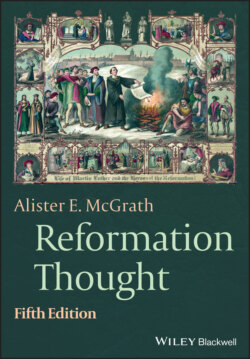Читать книгу Reformation Thought - Alister E. McGrath - Страница 23
The Religious Agendas of the Reformers
ОглавлениеThe fundamental conviction motivating the magisterial reformers, though to different extents, was that Christianity could best be reformed and renewed by returning to the beliefs and practices of the early church. The first five centuries – often designated “the patristic period” – tended to be regarded as the Golden Age of Christianity. There was some divergence within the movement over which early Christian writer offered the best intellectual foundation for such a program of doctrinal reform, with Augustine of Hippo being recognized as especially significant by many.
The great vision of many sixteenth-century reformers was summed up in the Latin slogan Christianismus renascens – “Christianity being born again.” The reformers pointed to the vitality of Christianity in the apostolic period, as witnessed by the New Testament, and argued that it was both possible and necessary to recapture the spirit and the form of this pivotal period in the history of the Christian church. It was necessary to go back to the New Testament and its earliest interpreters, in order to learn from them. These were the title-deeds of Christendom, the fountainhead of Christian belief and practice.
Standing in the great tradition of the Old Testament prophets, the reformers laid down a challenge to the religious leaders of their day. They saw the latter as guilty of condoning additions to and distortions of the Christian faith – alterations which reflected the interests of ecclesiastical fund-raisers and which fed popular superstition. The doctrine of purgatory and the related practice of selling indulgences were singled out as representing sub-Christian cults, exploiting the hopes and fears of the ordinary people. It was time to eliminate such corruptions through the consistent appeal to the beliefs and practices of the early church, which was held up as a model for the kind of shake-up and clean-out that the church so badly needed.
This emphasis upon early Christianity as resource, a norm, and point of reference for the sixteenth-century vision of Christianismus renascens allows us to understand why the reformers placed such great emphasis upon the New Testament and the early Christian writers – usually known as “the Fathers” or “the patristic writers.” It was in these writings that a blueprint for the reformation and renewal of the church was to be found, enabling a return to the original ideals of Christianity.
The production of the first Greek New Testament and reliable editions of the works of Augustine (regarded by most reformers as the patristic writer) during the first two decades of the sixteenth century were thus seen as milestones in the sixteenth-century program of reform and renewal, and became widely available throughout Europe. The great eleven-volume edition of Augustine’s works published by the two Amerbach brothers at Basle in 1506 is widely seen as a landmark in this process of retrieving and recalibrating his thought, especially in relation to the doctrine of grace. For Martin Luther, the program of reform at the University of Wittenberg around 1519 could be summed up in a simple phrase: “the Bible and St. Augustine.”
The rise of Renaissance humanism was widely regarded as providential, in that the great advances made in Hebrew and Greek studies in relation to classical texts in western Europe paved the way for the direct engagement with the scriptural text, in place of the unreliable Latin translation of the Vulgate. The new textual and philological techniques pioneered by the humanists were regarded as holding the key to the world of the New Testament, and hence authentic Christianity. As the sixteenth century entered its second decade, there were many who felt that a new era was dawning, in which the voice of authentic Christianity, silent for so long, would be heard once more.
Having explored some preliminary issues relating to this “Age of Reformation,” we shall now turn to consider some specific elements of the cultural backdrop to the Reformation, which help us understand its emergence and development.
